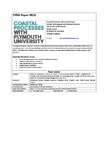Application of multiple linear regression and Bayesian belief network approaches to model life risk to beach users in the UK
| dc.contributor.author | Stokes, C | |
| dc.contributor.author | Masselink, Gerd | |
| dc.contributor.author | Revie, M | |
| dc.contributor.author | Scott, Tim | |
| dc.contributor.author | Purves, D | |
| dc.contributor.author | Walters, T | |
| dc.date.accessioned | 2017-03-16T08:34:57Z | |
| dc.date.available | 2017-03-16T08:34:57Z | |
| dc.date.issued | 2017-04 | |
| dc.identifier.issn | 0964-5691 | |
| dc.identifier.issn | 1873-524X | |
| dc.identifier.other | C | |
| dc.identifier.uri | http://hdl.handle.net/10026.1/8633 | |
| dc.description | publisher: Elsevier articletitle: Application of multiple linear regression and Bayesian belief network approaches to model life risk to beach users in the UK journaltitle: Ocean & Coastal Management articlelink: http://dx.doi.org/10.1016/j.ocecoaman.2017.01.025 content_type: article copyright: © 2017 Elsevier Ltd. All rights reserved. | |
| dc.description.abstract |
A data-driven, risk-based approach is being pursued by the Royal National Lifeboat Institution (RNLI) to guide the selection of beaches for new lifeguard services around the UK coast. In this contribution, life risk to water-users is quantified from the number and severity of life-threatening incidents at a beach during the peak summer tourist season, and this predictand is modelled using both multiple linear regression and Bayesian belief network approaches. First, the underlying levels of hazard and water-user exposure at each beach were quantified, and a dataset of 77 potential predictor variables was collated at 113 lifeguarded beaches. These data were used to develop exposure and hazard sub-models, and a final prediction of peak-season life risk was made at each beach from the product of the exposure and hazard predictions. Both the regression and Bayesian network algorithms identified that intermediate morphology is associated with increased hazard, while beaches with a slipway were predicted to be less hazardous than those without a slipway. Beaches with increased car parking area and beaches enclosed by headlands were associated with higher water-user numbers by both algorithms, and beach morphology type was seen to either increase water-user numbers (intermediate morphology in the regression model) or decrease water-user numbers (reflective morphology in the Bayesian network). Overall, intermediate beach morphology can be considered the most crucial contributor to water-user life risk, as it was linked to both higher hazard, and higher water-user exposure. The predictive skill of the regression and Bayesian network models are compared, and the benefits that each approach provides to beach risk managers are discussed. | |
| dc.format.extent | 12-23 | |
| dc.language | en | |
| dc.language.iso | en | |
| dc.publisher | Elsevier BV | |
| dc.subject | Bayesian network | |
| dc.subject | Multiple linear regression | |
| dc.subject | Lifeguard | |
| dc.subject | Rip current | |
| dc.subject | Beach users | |
| dc.title | Application of multiple linear regression and Bayesian belief network approaches to model life risk to beach users in the UK | |
| dc.type | journal-article | |
| dc.type | Journal Article | |
| plymouth.author-url | https://www.webofscience.com/api/gateway?GWVersion=2&SrcApp=PARTNER_APP&SrcAuth=LinksAMR&KeyUT=WOS:000397553700002&DestLinkType=FullRecord&DestApp=ALL_WOS&UsrCustomerID=11bb513d99f797142bcfeffcc58ea008 | |
| plymouth.volume | 139 | |
| plymouth.publication-status | Accepted | |
| plymouth.journal | Ocean & Coastal Management | |
| dc.identifier.doi | 10.1016/j.ocecoaman.2017.01.025 | |
| plymouth.organisational-group | /Plymouth | |
| plymouth.organisational-group | /Plymouth/Faculty of Science and Engineering | |
| plymouth.organisational-group | /Plymouth/Faculty of Science and Engineering/School of Biological and Marine Sciences | |
| plymouth.organisational-group | /Plymouth/REF 2021 Researchers by UoA | |
| plymouth.organisational-group | /Plymouth/REF 2021 Researchers by UoA/UoA07 Earth Systems and Environmental Sciences | |
| plymouth.organisational-group | /Plymouth/Research Groups | |
| plymouth.organisational-group | /Plymouth/Research Groups/Marine Institute | |
| plymouth.organisational-group | /Plymouth/Users by role | |
| plymouth.organisational-group | /Plymouth/Users by role/Academics | |
| plymouth.organisational-group | /Plymouth/Users by role/Researchers in ResearchFish submission | |
| dcterms.dateAccepted | 2017-01-23 | |
| dc.rights.embargodate | 2018-2-2 | |
| dc.identifier.eissn | 1873-524X | |
| dc.rights.embargoperiod | 12 months | |
| rioxxterms.versionofrecord | 10.1016/j.ocecoaman.2017.01.025 | |
| rioxxterms.licenseref.uri | http://www.rioxx.net/licenses/under-embargo-all-rights-reserved | |
| rioxxterms.licenseref.startdate | 2017-04 | |
| rioxxterms.type | Journal Article/Review |


